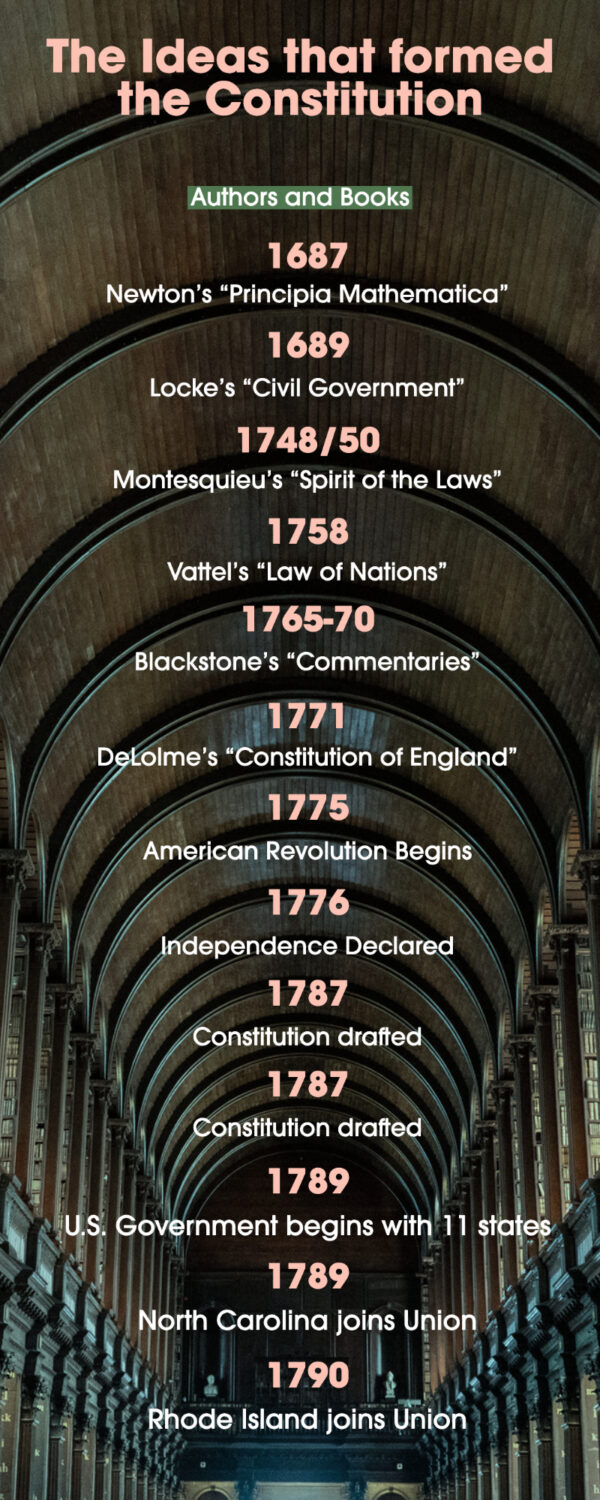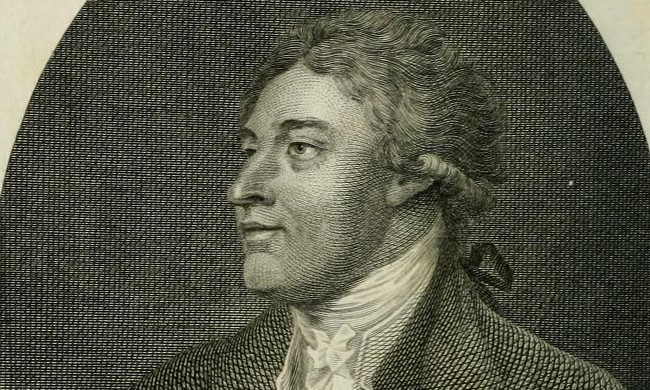This essay first appeared in the Feb. 23, 2023 Epoch Times.
Writers on the Constitution seldom mention the name of Jean-Louis DeLolme. This is unfortunate, because DeLolme’s book on the English political system significantly influenced those who participated in the constitutional debates of 1787–1790. The Constitution’s opponents—the Antifederalists—relied on it. And as the leading historian Gordon Wood testified, DeLolme’s book “had an extraordinary influence on Federalist thinking in the late 1780s as well.”
(Essay continues after timeline.)
 Like two of the Founders’ international law authorities (discussed in the next installment), DeLolme hailed from Geneva, Switzerland. Born in 1740, he was in the early stages of his law practice when one of his political pamphlets offended local officeholders. He thought it wise to embark on an extended vacation. He came to England.
Like two of the Founders’ international law authorities (discussed in the next installment), DeLolme hailed from Geneva, Switzerland. Born in 1740, he was in the early stages of his law practice when one of his political pamphlets offended local officeholders. He thought it wise to embark on an extended vacation. He came to England.
DeLolme was not well off financially. In England, he eked out a living by selling articles to magazines. Then in 1771, he published “Constitution de l’Angleterre.” It was published in the English language the following year under the title, “The Constitution of England; Or, An Account of the English Government.” It went through 10 successive editions.
DeLolme’s book examined the English political system through admiring eyes. Like Montesquieu, he celebrated its separation of powers, its (purportedly) unitary executive, and its respect for the rule of law.
In subsequent years, DeLolme updated new editions of “The English Constitution,” and wrote some other books as well. He eventually returned to Switzerland and died in 1806.
DeLolme and John Adams
In the first volume of John Adams’s “Defence of the [State] Constitutions of the United States” (a resource for many of the U.S. Constitution’s framers and ratifiers), Adams remarked, “[W]ho can think of writing upon this subject after DeLolme, whose book is the best defence of the political balance of the three [legislative, executive, and judicial] powers that ever was written.” Further, Adams quoted DeLolme’s observations about the temptations of power, even among men of goodwill:
“Experience evinces, that the happiest dispositions are not proof against the allurements of power, which has no charms but as it leads on to new advances. Authority endures not the very idea of restraint; nor does it cease to struggle, till it has beaten down every boundary.”
When the Constitution was proposed, most states had executive councils to check their state presidents and governors. During the ratification debates, some Antifederalists bemoaned the Constitution’s lack of an executive council. In No. 70 of “The Federalist,” however, Alexander Hamilton defended a unitary executive, citing DeLolme:
“I clearly concur in opinion in this particular with [DeLolme] … that ‘the executive power is more easily confined when it is one’; That it is far more safe there should be a single object for the jealousy and watchfulness of the people; and in a word that all multiplication of the executive is rather dangerous than friendly to liberty.”
Despite the British government’s fragmented structure, ultimately Parliament was supreme: Given enough time and determination, Parliament could always get what it wanted. As DeLolme wrote, “[I]t is a fundamental principle with the English Lawyers, that Parliament can do every thing [sic], except making a Woman a Man, or a Man a Woman.” (Of course, in some quarters today, that limitation would be considered a failure of imagination.)
In addition to Hamilton, several other participants in the ratification debates referred to DeLolme’s observations about the best structure for a government. However, the Swiss jurist’s greatest impact was not on structural issues, but on four other aspects of American constitutionalism: (1) the “censorial power,” (2) freedom of the press; (3) trial by jury, and (4) the Constitution’s introductory words.
The Censorial Power
In the Roman Republic (509–27 BCE), the people elected two “censors” every five years. The censorship was more revered than even the consulate, and those elected censors generally were senior statesmen who had previously served as consul.
The Latin verb behind the word “censor” (censēre) means to reckon, estimate, or assess. Neither in Roman times nor in the Founding era did the word “censor” necessarily have the negative connotations we associate with it today. The censors were tasked with conducting a census of Roman citizens. But they were also directed to correct harmful deviations in political practice. For example, they might prune the Senate of dead wood or immoral elements.
Obviously, this was an enormously powerful position, and in recognition of that, the censors’ term of office was limited to only six months. Thus, in four-and-a-half years of every five-year cycle, the republic had no censors at all.
DeLolme believed that other popular governments should institute a censorial power to correct harmful deviations, as a sort of constitutional gyroscope. Those exercising the censorial power necessarily had to be people outside the normal processes of government. They couldn’t be compromised by systemic corruption or dysfunction.
DeLolme believed England had a censorial institution: its free press. British newspapers and magazines had been very successful in revealing corruption and dysfunction and forcing political change.
After Independence, Americans followed DeLolme’s advice about creating a censorial power. The 1776 Pennsylvania constitution mandated the election of a “Council of Censors” every seven years to review governmental finances and operations and, if necessary, recommend constitutional change. The independent State of Vermont adopted a similar system in its 1777 constitution and reaffirmed it in a 1786 revision. Georgia’s 1777 constitution granted a majority of counties authority to force a statewide convention to adopt prescribed constitutional amendments. The 1780 Massachusetts constitution (drafted primarily by Adams himself) included a similar right, exercisable by two-thirds of the state’s voters after 15 years, to force an amendments convention.
The U.S. Constitution’s framers also created a censorial power. Under Article V, two-thirds of the state legislatures may force the calling of a “Convention for proposing Amendments.” As the Constitution’s advocates explained during the ratification debates, this empowered the states—through a convention they controlled and without federal interference—to propose amendments to correct federal dysfunction.
Today in many states the voter initiative is employed as a censorial power. (In some states the voter initiative is abused, but that’s another subject.) At the federal level, the censorial power has never been deployed, which, of course, explains a great deal about the modern condition of federal politics.
Freedom of the Press
A central objection to ratifying the Constitution was that it contained no guarantee of freedom of the press. One of the most respected Antifederalist writers, “The Federal Farmer,” made this case, and in doing so quoted DeLolme on the centrality of freedom of the press.
The popular demand for an amendment protecting the press was too strong for the Constitution’s advocates to ignore. This led to the inclusion of freedom of the press in the First Amendment of the Bill of Rights proposed in 1789, and fully ratified as of Dec. 15, 1791. (Actually, in Congress’s proposal the First Amendment was the third, but the original first was never ratified and the original second didn’t become part of the Constitution until ratified in 1992, as the 27th Amendment.)
Trial by Jury
The unamended Constitution guaranteed trial by jury only in criminal, not in civil cases. Moreover, the Constitution gave the Supreme Court more leeway to set aside a jury’s factual findings than was traditional at common law.
Antifederalists, including the “Federal Farmer,” objected to these restrictions on trial by jury. The Federal Farmer quoted DeLolme on this subject, also. Likewise, a Maryland Antifederalist essayist writing as “A Farmer” relied on DeLolme in arguing for an expanded trial by jury guarantee.
The Antifederalist demand for an expanded trial by jury guarantee was met by the Seventh Amendment. It assures jury trial in most civil cases in federal court, and limits the extent to which federal appeals courts can overturn a jury’s factual findings.
‘We the People’
Gouverneur Morris, a New Yorker who represented Pennsylvania at the 1787 convention, was assigned to write the Constitution’s final draft, and he inserted its opening phrase: “We the People ….”
The source of that phrase was very likely DeLolme. Near the end of DeLolme’s book on the English constitution, he speculated about what would have happened if a lawgiver had created the English constitution by design. To justify the House of Commons, DeLolme had the fictional lawgiver say, “We, the People, should have an influence upon Government ….”
****
Read prior installments here: first, second, third, fourth, fifth, sixth, seventh, eighth, ninth, tenth, eleventh. twelfth, thirteenth, fourteenth, fifteenth, sixteenth, seventeenth, and eighteenth.








